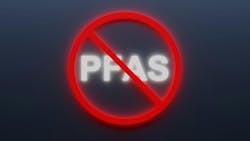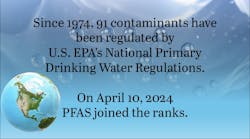EPA announces final PFAS Maximum Contaminant Levels (MCL)
The Environmental Protection Agency (EPA) has implemented new regulations to limit per- and polyfluoroalkyl substances (PFAS) in drinking water. This is the first brand new Maximum Contaminant Level (MCL) set by the EPA since arsenic was updated in 2001.
PFAS are human made chemicals that are difficult to break down and dispose of. They build up in human bodies when consumed through drinking water.
Six new MCLs for PFAS contaminants in drinking water
On April 10, 2024, U.S. EPA announced the final National Primary Drinking Water Regulation (NPDWR) for six PFAS contaminants.
These legally enforceable levels, MCLs, are set for: perfluorooctanoic acid (PFOA), perfluorooctane sulfonic acid (PFOS), perfluorohexanesulphonic acid (PFHxS), perfluoronoanoic acid (PFNA), FRD-903 (HFPO-DA, or Gen-X chemicals) and for mixtures containing two or more of the previous listed contaminants (PFHxS, PFNA, HFPO-DA and PFBS).
The final enforceable MCLs are set for the following:
• PFOA: 4.0 parts per trillion (ppt)
• PFOS: 4.0 ppt
• PFHxS: 10 ppt
• PFNA: 10 ppt
• HFPO-DA: 10 ppt
• Mixtures containing two or more of PFHxS, PFNA, HFPO-DA and PFBS: 1 (unitless) hazard index
Public water systems have until 2027 to complete initial monitoring of PFAS in their water. If this monitoring shows that PFAS is in drinking water that exceeds the above MCL’s then public water systems have until 2029 (five years) to implement solutions that reduce PFAS.
Beginning in 2029, public water systems that have PFAS in drinking water that violate one or more of these MCLS must take action to reduce levels and notify the public.
History of PFAS in drinking water
The EPA was first alerted to the risks of “forever chemicals” in 1998. Over a quarter century later U.S. EPA is setting limits on per- and polyfluoroalkyl substances (PFAS) in drinking water.
Although the EPA was not notified of the dangers of PFAS until 1998, its history as a contaminant date back to the 1930s. DuPont partnered with General Motors in 1930 to produce Freon. Freon is commonly used in things like air conditioning units, refrigerators and cars. Freon contains Kinetic Chemicals which are synthetic fluoropolymers that fall under the umbrella of PFAS.
Throughout the 1950s, and for decades to come, 3M manufactured PFAS at its plant in Cottage Grove Minnesota. A 1955 study, conducted by Gordon I. Nordby and J. Murray Luck, out of Stanford University, found that PFAS binds to human blood.
It was found in the 1970s that 3M was disposing of PFAS related materials into a landfill in the city of Lake Elmo, according to later court documents. It allegedly became known to 3M around this time that PFAS was accumulating in human blood. Throughout the 1980s and 1990s studies were conducted finding PFAS lingering in water sources, as well as in human blood.
Fast forward to 2009. EPA released Method 537, its first for analyzing PFAS. In 2010 Lake Elmo, Minnesota filed a lawsuit against 3M when PFAS was found to have contaminated public drinking water. In 2014, EPA’s Federal Facilities Restoration and Reuse Office (FFRRO) developed and published a fact sheet for PFAS related chemicals. EPA published a health advisory in 2016 for PFAS related chemicals stating that exposure to the chemicals at levels above 70 parts per trillion (PPT) could be dangerous.
About the Author
Alex Cossin
Associate Editor
Alex Cossin is the associate editor for Waterworld Magazine, Wastewater Digest and Stormwater Solutions, which compose the Endeavor Business Media Water Group. Cossin graduated from Kent State University in 2018 with a Bachelor of Science in Journalism. Cossin can be reached at [email protected].



